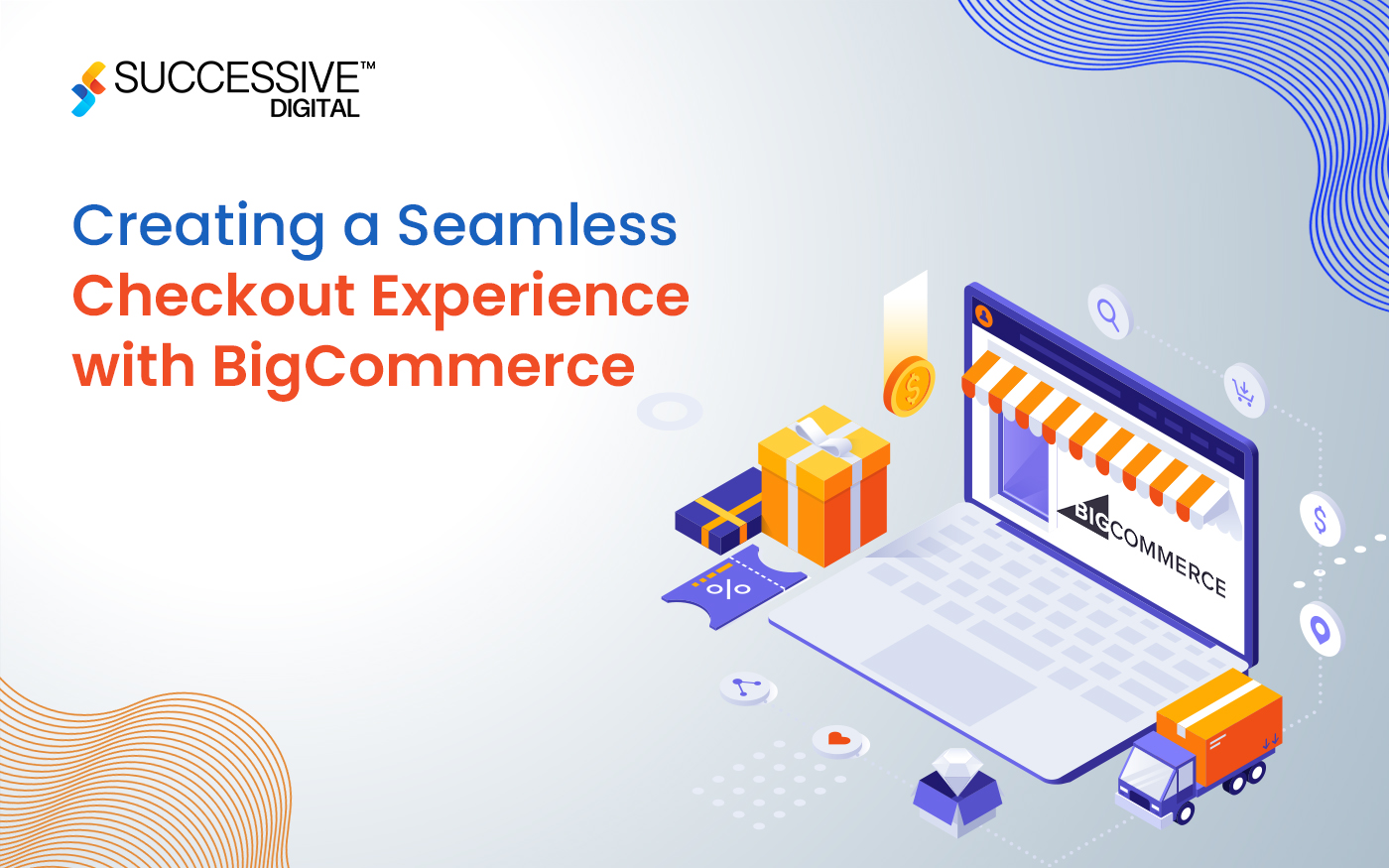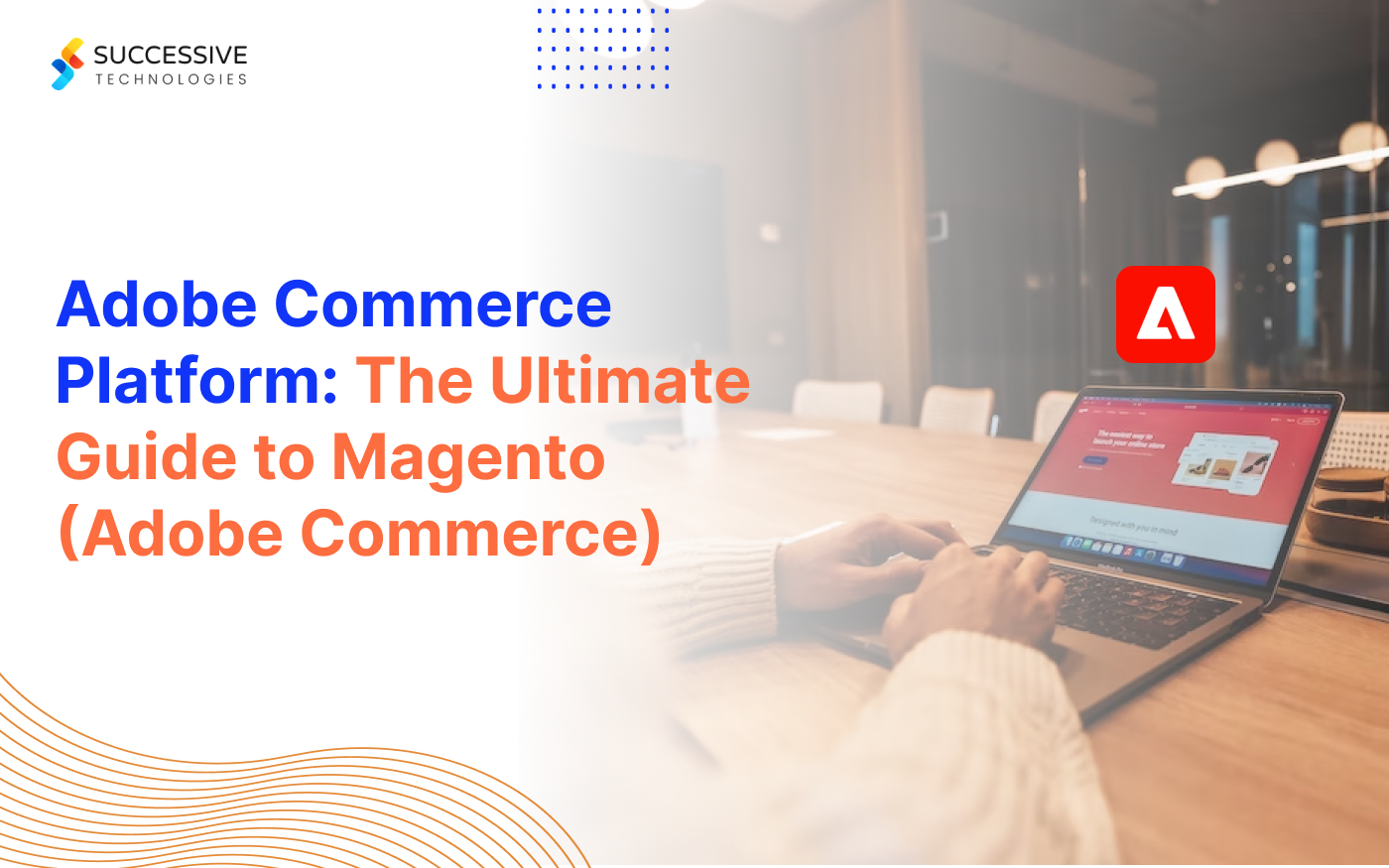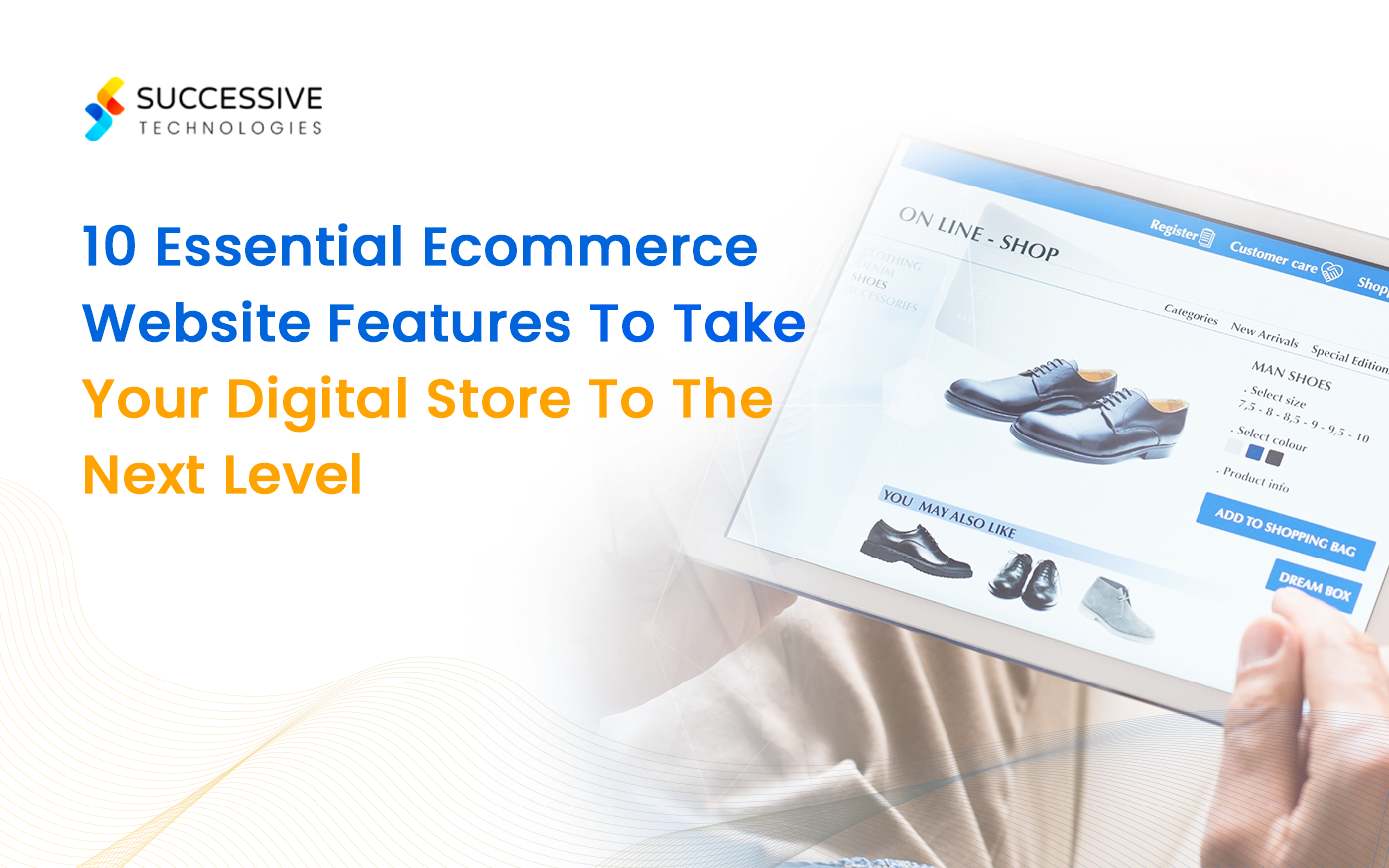Online shopping is gaining a generous amount of traction as more customers shop via digital platforms today. Recent studies have shown that online marketplaces globally recorded sales exceeding $3.25 trillion in 2023. Another study concluded that about 50% of online purchases are derived from online marketplaces. These studies explain the dominance of marketplaces over a single eCommerce platform. It also shows how much potential a multi-vendor marketplace holds if you invest in it.
Amazon, Alibaba, and Walmart are some of the excellent examples of multi-vendor marketplaces that are thriving today. If you are a business that wishes to thrive like these eCommerce giants, then keep reading this blog!
What is a Multi-Vendor Marketplace?
A multi-vendor marketplace is an online eCommerce portal where different vendors sell their products to the target audience. This marketplace offers a vast product catalog to customers and vendors with a large customer base.
The difference between a single-vendor and multi-vendor eCommerce marketplace is that the former does not acquire or manage multiple sellers, while the latter does.
In a multi-vendor marketplace, a vendor owns a seller account to manage the inventory and receive orders by paying a commission to the owner. In return, these eCommerce marketplaces help sellers to meet their curated customer base and grow sales.
In a nutshell, it is a portal that brings sellers and buyers together on a single online platform benefiting both parties as they play their part in smooth functionality of digital shopping space.
How Does a Multi-Vendor Marketplace Work?
The work of a multi-vendor marketplace begins when a user browses the platform and looks for their preferred product via the search feature. The marketplace then responds back with a variety of product results listed by multiple vendors (who have registered with the marketplace), from which the customer can select a product and place an order.
Once the user completes an order payment, it is put under the order confirmed category, and the details are sent to the respective vendor. The vendor then takes up the order fulfillment task and utilizes their inventory and logistics operations to ensure the product is delivered in the given time frame (as displayed on the marketplace).
For revenue, the marketplace owner takes a small part of the order payment, also called commission, while the vendor keeps the rest of the payment as their earning amount.
Looking to set up a multi-vendor website? Consult with our multi-vendor eCommerce website developers and get customized solutions for your business.
Benefits of Multi-Vendor Marketplace Development
Multi-vendor marketplace development has a wide range of benefits not only for users, but also for vendors and marketplace owners. Let us have a look at them from each stakeholder’s perspective.
Benefits for Vendors
- Seamless Product Listing
With a multi-vendor marketplace, vendors can easily list their products under their name without having to manage the store on their own. Let us take the example of Amazon, it allows multiple vendors to list their products and showcase their brand under their name without having them incur any website setup and maintenance costs.
- Access to a Wide Customer Base
While a single-vendor store limits the accessibility of the target audience, a multi-vendor eCommerce store allows vendors to expand their product reach to a wider base, no matter where they are located. With marketplaces such as Amazon and eBay, vendors are making their products available to a global audience.
- Secure Environment to Conduct Business
A multi-vendor eCommerce marketplace is a cloud-based platform that is a secure place for vendors. This means neither of their product data will be vulnerable to security issues, and its protection will be the optimal responsibility of the marketplace owners.
Benefits for Users
- Wide Variety of Products
On a single-vendor store, users are bound to limited products since only a single vendor has listed their products. This creates limitations in color availability, size availability, and sometimes, quality. But that’s not the case with multi-vendor marketplace. Here multiple vendors list their products, which provides a wide array of product choices and an option for customers to choose the best product as per their requirements and budget.
- Accessibility to Best Deals and Discounts
Users get open access to utilize the best deals and discounts provided by the marketplace platform. Usually, marketplaces launch seasonal sales and festive sales to promote sales. Users can leverage them, buy products at a cheaper price, and save BIG on products such as Apple products (iPhone and MacBook) that are otherwise very expensive.
- Holistic View of Vendor’s Rating
In the modern shopping era, ratings and reviews impact product purchase decisions heavily. One of the major benefits of multi-vendor eCommerce development is that it provides a holistic view of each vendor’s rating. This enables customers to make an informed decision and make a purchase from a vendor whose rating and feedback is satisfactory.
Benefits for Marketplace Owners
- Bigger Profits
With multi-vendor marketplace development, marketplace owners can earn higher profits as the product listed on the platform is usually listed with a higher price range. This allows them to earn higher commission for each sold product and boost their revenue graph. During the seasonal and festival sale hours, the product sales tend to increase more than usual, which creates another opportunity for owners to attain a profit margin.
- No Requirement of Inventory Management
Since the vendors who have listed their products on the platform are responsible for maintaining SKUs and logistics, the inventory management operations are no longer the obligation of a multi-vendor marketplace owner. You just need to run the marketplace platform efficiently while the order fulfillment process is conducted by your associated vendors.
- Can Focus on Brand Promotions
Since the major eCommerce operations, such as order management, order fulfillment and shipping, and inventory management, are handled by the vendors themselves, marketplace owners can focus on other business functions such as advertisement, campaigns, and brand promotions. This will help in attracting prospective vendors and end customers to utilize their marketplace platform.
Types of Multi-Vendor Marketplace
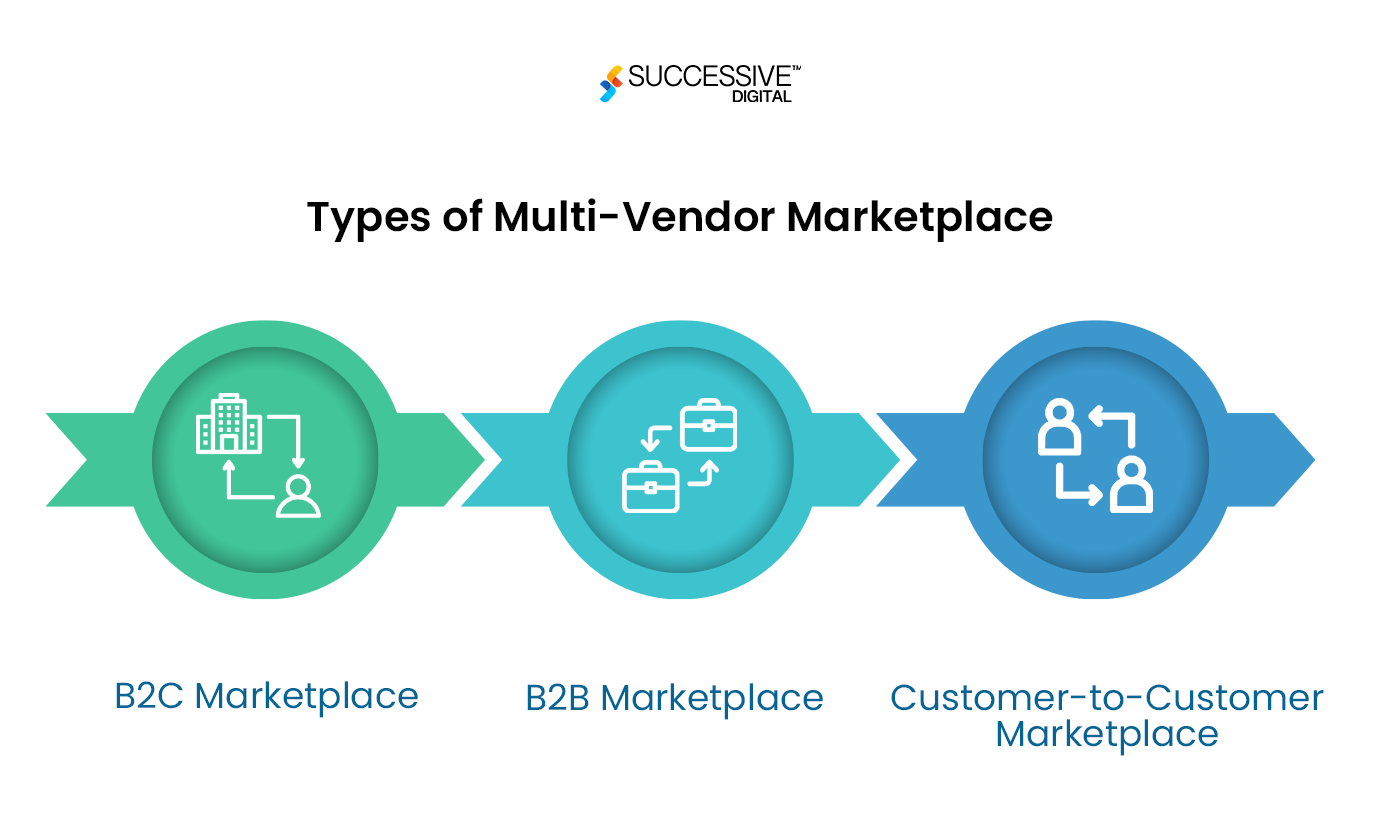
- B2C Marketplace
A B2C multi-vendor marketplace includes a model where a business sells directly to customers. The business uses vendors’ support to ensure the order fulfillment and inventory management processes are handled efficiently. Some of the best examples of this model are Amazon, Walmart, and Airbnb.
- B2B Marketplace
A B2B marketplace is a platform that includes two parties, similar to the B2C model: the seller and the buyer. But what makes it different is that business is conducted between two businesses. The seller includes brands, manufacturers, wholesalers, and suppliers, while the buyer includes other businesses that purchase products in bulk. A few examples of B2B marketplaces include Walmart and Alibaba.
Want to learn more about what’s happening in the B2B space? Get your hands on our latest blog, where we unravel the top B2B eCommerce trends and explain their potential for success in this domain.
- Customer-to-Customer Marketplace
This type of multi-vendor marketplace allows a person (a customer) to sell their existing products to other customers, labeling them as second-hand products. eBay is an excellent example of this marketplace category.
Step-by-Step Process of Multi-Vendor eCommerce Development
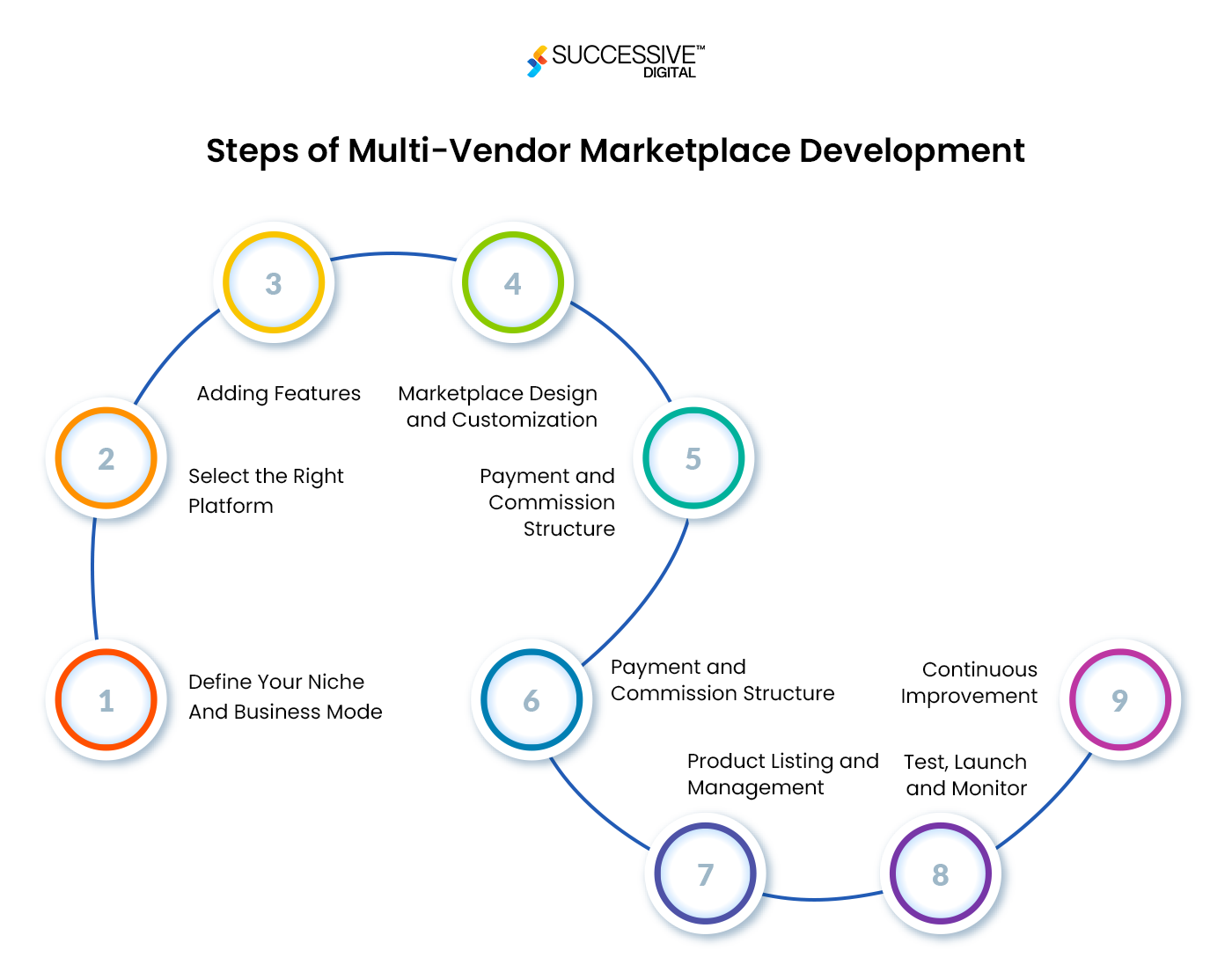
- Define Your Niche And Business Model
The first step in multi-vendor eCommerce development is to determine the industry niche and business model you wish to build the platform for. Will it be goods, fashion, or electronics? Once you decide the niche, identify what will be your pricing strategy. For example decide upon whether you will make an earning from commission or subscription?
- Select the Right Platform
After that select the suitable eCommerce platform. Here the eCommerce development company will help you. They will assist in platform selection after understanding your specific needs.
BigCommerce, Shopify, and Adobe Commerce are popular options. When selecting a platform, consider the following criteria:
- User experience and design
- Scalability
- Integration with other systems (such as payment gateways and shipping providers)
- Security
- Cost
- Adding Features
Now that the development platform is finalized, you need to determine what features are required in the marketplace and direct the eCommerce development team to add them accordingly. Remember that there are some essential features (discussed in the next section) that should be added in the marketplace plus some custom features which you can ensure to add to boost the marketplace’s performance and functionality.
- Marketplace Design and Customization
Marketplace’s storefront design is a major player in making or breaking a deal. Hence, it has to be thoroughly thought of and then implemented.Make sure to pick a visually appealing theme and design that aligns with the identity of your marketplace and eventually augments your brand.
As a professional creative design company, we recommend building a custom design. This will help you build a seamless user experience and highlight your distinctive branding.
- Payment and Commission Structure
Establish a safe and practical payment mechanism. You need to add multiple payment gateways for smooth customer payments, automated payments to vendors, and timely commission collection directly in your bank account after successful sales.
Ask the development team to integrate payment gateways such as Stripe and PayPal for smooth and safer transactions.
- Vendor Onboarding and Setup
One of the critical steps in multi-vendor eCommerce website development is streamlining the vendor onboarding process. In this step, you need to acquire and onboard vendors, help them register with your multi-vendor marketplace portal, and make them acquainted with how your revenue model works.
- Product Listing and Management
After registering with your multi-vendor marketplace store, allow vendors to list their products along with thorough descriptions, images, and costs. Also, build a review mechanism where customers can add reviews and ratings to increase transparency. This will also help new customers feel satisfied when making a purchase decision.
- Test, Launch and Monitor
The next step in multi-vendor eCommerce website development is to test the marketplace for functionality, performance, and underlying bugs, if any. The QA team at Successive Digital conducts thorough testing procedures to fix issues before the big launch. Once it gets a green flag, it is pushed to launch. Thereafter, monitoring is done to check usage statistics, marketplace traffic, and performance.
- Continuous Improvements
Once the launch period is over, the real work begins. This means implementing a continuous improvement approach. The multi-vendor eCommerce website developers you hire for your project will continuously make iterations based on customer preferences, emerging trends, and technological advancements.
Essential Features of a Multi-Vendor Marketplace
A successful multi-vendor eCommerce marketplace covers various essential features to ensure optimal functionality. The features are bifurcated into three sections: user interface, vendor interface, and admin interface. Let us have a look at all these features in detail.
Features for Vendors
- Registration and Personalized Vendor Panel
This is one of the most important features for a multi-vendor marketplace as it will allow vendors to get registered on your marketplace by providing their details and establishing their shop. Once registered, they can begin listing their products and can come back later to log in to the vendor panel, manage products, and facilitate orders. Also, note that the panel should be personalized to create an enhanced experience for the vendors.
- Shipping Integration
Your marketplace should include various shipping services, allowing vendors to manage and facilitate product shipment for multiple orders easily.
- Push Notifications
Push notifications should not be limited to end users. Instead, the vendors should also get ongoing updates in the name of push notifications to have real-time updates on when an order is placed for their products and when it is delivered.
- Real-Time Inventory Updates
A vendor should be provided with real-time updates on inventory status to keep track of product availability at delivery time.
- Product Listing and Feature Information
This is another crucial feature as it will enable the vendors to add their products to the marketplace portal and provide detailed information such as features, product images, specifications, and brief information about themselves for transparency.
- Automated Payment Withdrawal
While vendors are listing their products on your platform, they will expect automated payment retrieval once the users make a payment. Add this feature to the marketplace for smooth payment processing to vendors.
Features for Users
- Login / Sign-Up
This is the foundational feature of a multi-vendor marketplace. Provide users with an easy login and sign-up process should be delivered to the user. Also, the user account includes various sensitive information like eWallet, personal details, etc., which needs protection via two-factor authentication.
- User-friendly Interface and Checkout
The UI of your eCommerce marketplace should be easy to navigate and allow the users to easily locate multiple products as per their preference. Also include a custom checkout process within your marketplace to enable them to make purchases quickly. Both product navigation and checkout are the deal breakers and encourage users to make purchases in one go.
Learn more about the significance of custom checkout with our blog on custom checkout solution and its importance in building better customer experiences.
- Order Placement
Since customers view multiple products on the multi-vendor marketplace, they may also prefer to buy multiple products that are available from numerous vendors. For example, they might prefer to buy a pair of shoes from Vendor A and a pair of jeans from Vendor B. Therefore, they should have the ability to combine numerous products from various vendors and place one single order for them.
- Tax Management
Since the tax rates may change as per the location or the product; therefore, add a tax management feature to estimate specific taxes and display the same to users for better price transparency. You can utilize tax calculation tools that will use the information to calculate the tax as per the region.
- Real-time Order Tracking
Order tracking feature improves the customer experience and builds trust. Thus, your multi-vendor eCommerce marketplace should integrate GPS tracking ability to allow users to track their order’s live location and status in real-time.
- Rewards and Offers
Your users should be given various offers, discounts, and reward cashback, which can make your customers repeatedly visit your marketplace. Also, you can integrate the feature where users can bid on the product within the price range.
- Payment Setup
This is also another important feature for a multi-vendor marketplace, as getting users to make a payment is the core of why you’re running the eCommerce business in the first place. Hence, add multiple payment options such as digital wallets, credit/debit cards, net banking, cash on delivery, and Buy Now Pay Later for smooth payment processing.
- Push Notifications
Add a push notification feature to send regular alerts to your existing and potential customers and keep your brand’s name in their subconscious mind. Remind them of new deals, discounts, and upcoming sales, which will directly encourage them to shop and make a purchase. However, make sure to personalize the notifications to bring a smile to their face once they read it! Take an example of Amazon here. It regularly sends personalized email notifications and mobile alerts to its customers, which eventually encourages them to open the website or app and make a purchase.
- Product Reviews and Ratings
Allow users to give product feedback upon your multi-vendor marketplace, where they can write honest reviews and give ratings of their experience. This will help fellow customers to read these reviews and decide upon which is the best product among the various options available.
- Bulk Order Feature for B2B Marketplaces
Provide a bulk order feature in the B2B business model to allow the B2B buyers to make bulk purchases with ease. Also enable a recurring setting so that an automatic order purchasing can be set up for these buyers.
Features for Admin
- Vendor Onboarding Panel
The admin will collect the necessary information and documents from the sellers to onboard them as vendors in their marketplace store. After successful onboarding, these vendors can begin conducting online business.
- Customized Admin Dashboard
Include a customized admin dashboard that will include all the necessary information about the vendors and their products, including product/vendor category, product view, offers listed, etc., as well as the customers once they sign up with the portal. Note that this is an important feature of a multi-vendor marketplace that will enable easy vendor and customer management for the admin.
- Inventory Management
Admin should be able to track the inventory status in real-time to manage operations efficiently and minimize the chances of understocking or overstocking. They can add multiple inventory management tools which are complementary with eCommerce platforms (shopify and BigCommerce). This will allow them to keep track of supplies, optimize delivery schedules, and ensure SKUs never run out of supplies.
- Reports and Data Analytics
Data is a valuable aspect of a multi-vendor eCommerce marketplace. Integrate reporting and analytics features within the dashboard to analyze sales reports, monitor customers’ purchase behavior for better product recommendations, and predict customer demands to ensure inventory can meet that demand.
- Order Management System
Since a multi-vendor marketplace contains numerous vendors and products, streamlining orders from a vendor to the customer is necessary. Utilize an OMS software and integrate it within the portal. This will be helpful in categorizing the orders product-wise and vendor-wise and facilitate order tracking and return or refund.
- Manage Storefronts
Admin can create and manage new storefronts for your multi-vendor eCommerce store based on language choice, currency, vendors, and products. This will help in better customer targeting and order fulfillment.
- Product Review Management
This is another essential feature of a multi-vendor marketplace. This will allow the admin to manage product reviews, establish the product’s reputation, and promote brand value among customers. Admin can list the high-value items and the reviews at the top to encourage more sales for these particular products. If a new item gets higher reviews they can send a push notification and encourage customers to purchase it.
Final Verdict
The online shopping landscape is quickly adapting, and customers, no matter whether B2B or B2C, are expecting more product variety that is also lower in price. This is why they search for their preferred products on online marketplaces that provide them with everything they expect from a product in just a few clicks. However, building a successful multi-vendor marketplace is not an easy task. It requires certain steps, as shared above.
Furthermore, if you are looking for fully customized multi-vendor marketplace development, then hire Successive Digital as your eCommerce development partner. Our experienced developers will work closely with you to understand your requirements and build a custom solution accordingly.










